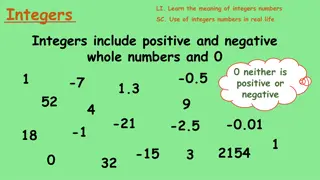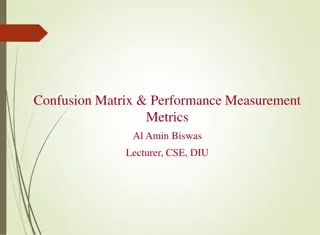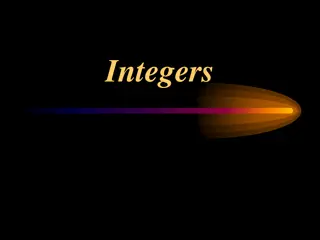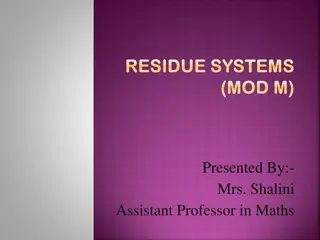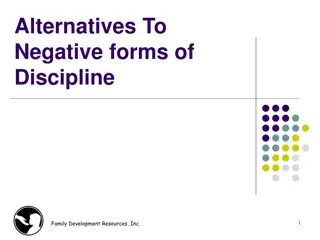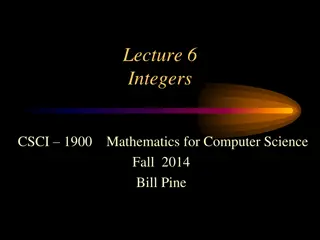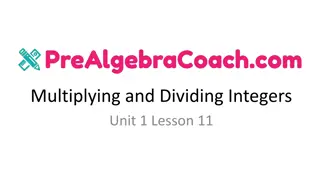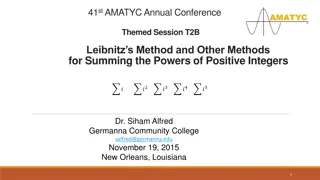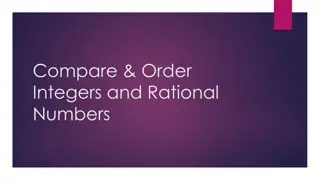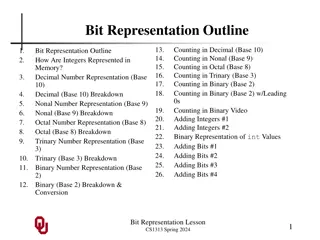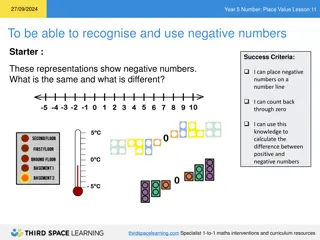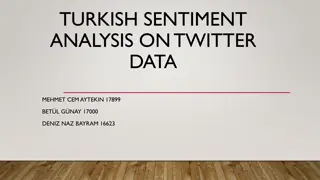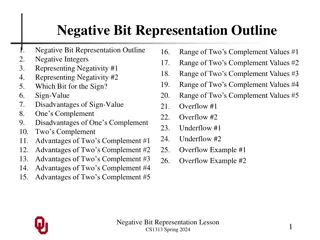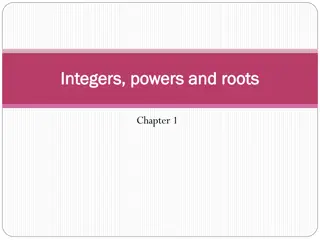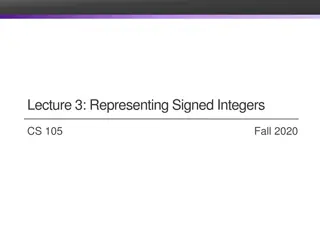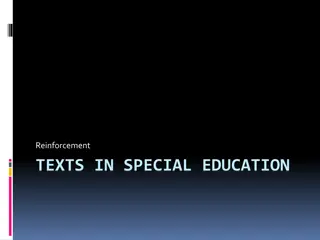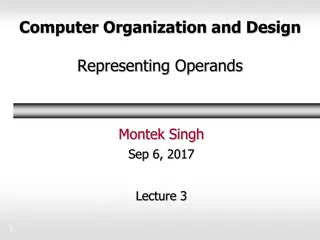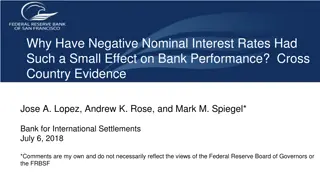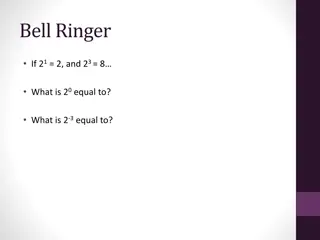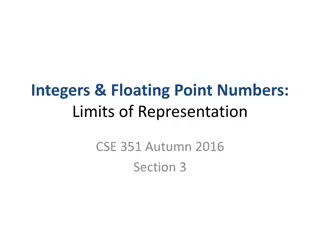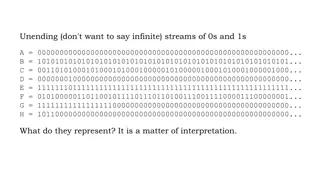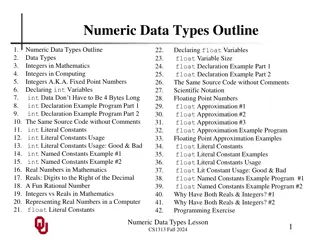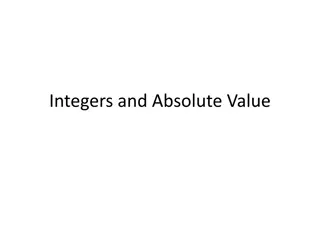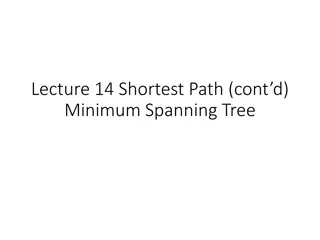Understanding Signed Integers and Addition in Computational Systems
Dive into the world of signed integers, extensions, truncations, and addition in computer science with a focus on how negative values are represented and operated on. Explore concepts like sign-magnitude and two's complement representations, uncovering the intricacies of handling integers in computa
5 views • 25 slides
Understanding Divisibility and Modular Arithmetic in Discrete Structures
This lecture discusses the concepts of divisibility and modular arithmetic in the context of discrete structures. It covers definitions, notation, and examples of divisibility by integers, including proving properties such as the divisibility of products and consecutive integers. Through practical e
1 views • 43 slides
Understanding Integers: Real-life Applications and Examples
Explore the world of integers, encompassing both positive and negative whole numbers along with zero. Discover practical instances where integers are encountered, such as temperature readings, financial transactions, and positional indicators like floors in a building. Dive into scenarios where nega
0 views • 34 slides
Understanding Confusion Matrix and Performance Measurement Metrics
Explore the concept of confusion matrix, a crucial tool in evaluating the performance of classifiers. Learn about True Positive, False Negative, False Positive, and True Negative classifications. Dive into performance evaluation metrics like Accuracy, True Positive Rate, False Positive Rate, False N
3 views • 13 slides
Understanding Operations with Integers
Integers are whole numbers and their opposites. Learn about addition, subtraction, multiplication, and division of integers. Follow specific rules based on the signs of the numbers involved to correctly perform operations. This educational presentation provides clear explanations and visual examples
0 views • 13 slides
Understanding Residue Systems and Euler's Phi Function in Mathematics
Residue Systems, also known as Reduced Residue Systems, play a significant role in number theory. They involve concepts like the Euler Phi Function, which counts integers relatively prime to a given number. Complete Residue Systems and their properties are explored, highlighting the least non-negati
3 views • 11 slides
Understanding Integer Multiplication with Examples
Explore the concept of multiplying integers with examples of same and different signs. Learn how the product changes based on the signs of the numbers involved. Step-by-step examples demonstrate how to determine whether the result will be positive or negative. Additionally, engage in practical scena
2 views • 14 slides
Understanding Positive Discipline Techniques for Effective Parenting
Children have the right to a nurturing environment free from violence and shame. Negative discipline methods like spanking and yelling can have long-lasting negative impacts on a child's development. By understanding the reasons behind negative discipline practices and exploring alternative positive
1 views • 15 slides
Understanding Euclid's Algorithm: An Ancient Approach to Finding Greatest Common Divisors
Euclid's Algorithm, dating back 2500 years, offers a simpler method to find the greatest common divisor (gcd) of two non-negative integers compared to traditional factorization. By iteratively applying a rule based on the gcd of remainders, it efficiently computes gcd values. The basis of the algori
0 views • 15 slides
Exploring Integers, Divisibility, and Prime Numbers in Mathematics for Computer Science
Discover the fundamental concepts of integers, divisibility, remainder theorem, prime numbers, and their applications in computer science. Learn about integer division, examples of remainders, properties of divisibility, and the significance of prime numbers in cryptography. Explore the interplay be
0 views • 26 slides
Understanding Integer Division, Modulus, and Parity
Explore the concepts of integer division, modulus, and the parity of integers through the quotient-remainder theorem. Learn how to compute div and mod manually and understand the representation of integers as even or odd. Discover how these principles apply in computer languages and the unique prope
0 views • 18 slides
Understanding Multiplying and Dividing Integers Unit 1 Lesson 11
In this lesson on multiplying and dividing integers, students will learn how to apply rules for multiplication, including when integers have the same or different signs. Key vocabulary includes integers, negative numbers, and positive numbers. Sample problems are provided to practice multiplying int
0 views • 51 slides
Understanding Exchange Rate Behavior with Negative Interest Rates: Early Observations by Andrew K. Rose
In this study, Andrew K. Rose examines the exchange rate behavior in economies with negative nominal interest rates, focusing on the impact and implications of such rates on exchange rates. The findings suggest limited observable consequences on exchange rate behavior, with similarities in shocks dr
0 views • 42 slides
Exploring Sums of Powers of Positive Integers Through Leibnitz's Method
Students are introduced to the computation of sums of powers of positive integers through Leibnitz's Method and other techniques in the context of finding areas under curves and exploring integration. The presentation delves into the origins of these formulas and their computation, reflecting on the
0 views • 24 slides
Understanding Integers and Rational Numbers Through Examples
Explore a series of questions that involve comparing and ordering integers and rational numbers, along with practical scenarios like determining temperatures and organizing prices. Test your knowledge on identifying rational numbers, understanding integer properties, and arranging numbers in sequenc
0 views • 16 slides
Understanding Integer Representation in Computer Memory
Explore the binary representation of integers in computer memory, covering decimal, nonal, octal, trinary, and binary numbering systems. Learn how integers are stored using sequences of bits and decipher the breakdown of numbers in different bases. Discover the Arabic digits in decimal representatio
0 views • 26 slides
Exploring Infinity: From Countable Integers to the Unbounded Real Numbers
Delve into the realm of infinity, where the concept transcends our finite understanding. Discover how the set of positive integers, even numbers, all integers, positive rational numbers, and real numbers each showcase a distinct level of infinity. Explore the notion of cardinality, bridging the gap
0 views • 9 slides
Understanding Net Worth: Integers and Financial Assets
Learn about net worth, liabilities, and assets by exploring how integers are used to determine the financial standing of individuals. Discover the concepts of liabilities, responsibilities, and assets through real-life examples of notable personalities. Dive into calculations and understand how net
0 views • 18 slides
Guide to Giving Negative Commands in Spanish
Learn how to effectively communicate what not to do in Spanish with negative commands. Understand the different forms of negative commands for -AR, -ER/-IR verbs, irregular verbs, direct object pronouns, stem-changing verbs, and verb forms ending in -CAR, -GAR, -ZAR. Master the rules and exceptions
0 views • 12 slides
Understanding Negative -T Commands in Spanish
Negative -T commands in Spanish are used to tell someone what not to do. These commands are often directed at friends or familiar individuals. Forming negative -T commands involves starting with the YO form in the present tense, dropping the O for -ER/-IR verbs, adding -ES for -AR verbs, and includi
0 views • 50 slides
Exploring Negative Numbers in Year 5 Mathematics Lesson
In this Year 5 mathematics lesson on negative numbers, students learn to recognize and use negative numbers through various activities such as placing them on a number line, counting back through zero, and calculating the differences between positive and negative numbers. The lesson also prompts stu
0 views • 23 slides
Implementing Turkish Sentiment Analysis on Twitter Data Using Semi-Supervised Learning
This project involved gathering a substantial amount of Twitter data for sentiment analysis, including 1717 negative and 687 positive tweets. The data labeling process was initially manual but later automated using a semi-supervised learning technique. A Naive Bayes Classifier was trained using a Ba
0 views • 17 slides
Understanding Positive Behavior Acknowledgment in Children
Acknowledging children's positive behaviors is crucial for reinforcing desired behavior patterns. Positive responses help in promoting positive interactions, following instructions, proper communication, and independent self-care skills. It is important to recognize and praise positive behaviors to
0 views • 11 slides
Exploring the Possibility of People with Negative Height
This article delves into the theoretical concept of people with negative height, discussing the probabilities based on normal distribution models and empirical rules. It explores the likelihood of encountering individuals with negative height in today's population, throughout history, and the number
0 views • 10 slides
Understanding Negative Bit Representation in Computer Science
Dive into the world of negative bit representation in computer science, exploring the need for representing negativity in integers, methods like Two's Complement, disadvantages of Sign-Value and One's Complement, range of Two's Complement values, overflow, underflow, and more. Discover the significa
0 views • 26 slides
Non-Negative Tensor Factorization with RESCAL
This article discusses non-negative tensor factorization with RESCAL, covering topics such as Non-Negative Matrix Factorization, Multiplicative Updates, RESCAL for Relational Learning, and Non-Negative Constraint for RESCAL. It explores how factorizing matrices/tensors into non-negative factors can
0 views • 11 slides
Understanding Integers, Powers, and Roots: A Comprehensive Guide
Explore the world of integers, powers, and roots in this educational chapter. Learn how to multiply and divide integers, calculate squares and square roots, understand laws of indices, and master the order of operations. Discover concepts like LCM, HCF, prime factorization, natural and rational numb
0 views • 24 slides
Understanding Signed Integer Representations in Computer Science
Explore various methods of representing signed integers in computer memory, including sign-magnitude, excess-K, and two's complement. Learn about binary numbers, important signed values, and how to perform calculations with signed integers. Delve into exercises to solidify your understanding.
0 views • 31 slides
Understanding Positive and Negative Reinforcement in Special Education
Positive reinforcement involves rewarding good behavior in children, such as praise or rewards, while negative reinforcement motivates change by removing something unpleasant. Positive reinforcement is usually more effective and includes examples like praising a child for putting away dishes or rewa
1 views • 5 slides
Understanding Information Encoding in Computer Organization and Design
Discussions in this lecture delve into the importance and methodology of representing operands in computer systems, covering topics such as encoding characters, integers, positive and negative numbers, fixed-point and floating-point numbers. The motivation behind using binary representation is explo
0 views • 35 slides
Understanding Hash Tables and Handling Collisions
This content covers the concepts of hash tables, handling collisions, and efficient implementation of dictionary operations. It explores methods like direct-access tables, converting keys to non-negative integers, and using functions to work with non-integer keys. The discussion includes approaches
0 views • 32 slides
Impact of Negative Nominal Interest Rates on Bank Performance
Negative nominal interest rates, implemented following the financial crisis, have had a limited effect on bank performance globally. While low rates reduce profitability, banks have shown resilience through adjustments in funding allocations and non-interest income sources. Studies suggest that resp
0 views • 34 slides
School Food Service Update and Financial Overview
Within the School Food Service update, information is provided on negative account balances, personal parent notifications, and payment options available to parents. The data includes details on total negative balances, number of families contacted, and payment methods. Challenges with negative bala
0 views • 5 slides
Understanding Exponents: Zero, Negative, Multiplication, and Division
Explore the concepts of zero and negative exponents, learn how to handle them, and understand the rules for multiplying and dividing numbers with exponents. Remember, anything to the zero power is equal to one, and negative exponents can be transformed into positive by converting the base number int
0 views • 7 slides
Understanding Integer and Floating Point Number Representations
Exploring the limitations and design decisions behind representing integers and floating point numbers in memory. Learn about unsigned and signed integers, two's complement, as well as key values and concepts to remember. Delve into the vision behind floating point numbers and their representation f
0 views • 20 slides
Understanding Binary Numbers and Their Representation in Mathematics
Explore the world of binary numbers through a series of infinite 0s and 1s, representing integers and real numbers between 0 and 1. Dive into the interpretation of these binary sequences as natural numbers, integers, and fractions, shedding light on the concepts of trans-finite numbers and their pla
0 views • 16 slides
Understanding Numeric Data Types in Programming
Exploring the world of numeric data types, this content delves into the concepts of integers and real numbers in mathematics as well as their representation in computing. It covers the use of literal constants, named constants, and the differences between integers and real numbers. The content also
0 views • 42 slides
Understanding Integers and Absolute Value Concepts
This content covers the definitions and examples of integers, integers on a number line, opposites of numbers, absolute value, and real-life applications related to freezing points. Explore the concept of integers, their representation on a number line, absolute value calculations, and practical sce
0 views • 9 slides
Bellman-Ford Algorithm: Shortest Path with Negative Edge Length
The Bellman-Ford algorithm addresses the challenge of finding the shortest path in graphs with negative edge lengths, particularly useful in scenarios such as arbitrage in currency exchange rates. By utilizing dynamic programming and steps iteration, the algorithm efficiently detects negative cycles
2 views • 16 slides
Mathematics Classroom Resources and Activities
Dive into an array of resources and activities for the math classroom, including distributing workbooks, reviewing integer rules, practicing adding and subtracting integers, and mastering multiplying and dividing integers. Engage students with classwork packets and homework assignments to reinforce
0 views • 8 slides


